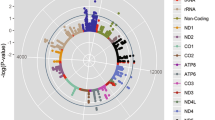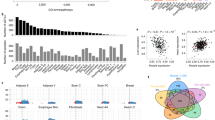Abstract
More than a billion humans worldwide are predicted to be completely deficient in the fast skeletal muscle fiber protein α-actinin-3 owing to homozygosity for a premature stop codon polymorphism, R577X, in the ACTN3 gene. The R577X polymorphism is associated with elite athlete status and human muscle performance, suggesting that α-actinin-3 deficiency influences the function of fast muscle fibers. Here we show that loss of α-actinin-3 expression in a knockout mouse model results in a shift in muscle metabolism toward the more efficient aerobic pathway and an increase in intrinsic endurance performance. In addition, we demonstrate that the genomic region surrounding the 577X null allele shows low levels of genetic variation and recombination in individuals of European and East Asian descent, consistent with strong, recent positive selection. We propose that the 577X allele has been positively selected in some human populations owing to its effect on skeletal muscle metabolism.
This is a preview of subscription content, access via your institution
Access options
Subscribe to this journal
Receive 12 print issues and online access
$209.00 per year
only $17.42 per issue
Buy this article
- Purchase on Springer Link
- Instant access to full article PDF
Prices may be subject to local taxes which are calculated during checkout




Similar content being viewed by others
Accession codes
References
Mills, M. et al. Differential expression of the actin-binding proteins, α-actinin-2 and -3, in different species: implications for the evolution of functional redundancy. Hum. Mol. Genet. 10, 1335–1346 (2001).
North, K.N. et al. A common nonsense mutation results in α-actinin-3 deficiency in the general population. Nat. Genet. 21, 353–354 (1999).
Yang, N. et al. ACTN3 genotype is associated with human elite athletic performance. Am. J. Hum. Genet. 73, 627–631 (2003).
Niemi, A.K. & Majamaa, K. Mitochondrial DNA and ACTN3 genotypes in Finnish elite endurance and sprint athletes. Eur. J. Hum. Genet. 13, 965–969 (2005).
Clarkson, P.M. et al. ACTN3 genotype is associated with increases in muscle strength in response to resistance training in women. J. Appl. Physiol. 99, 154–163 (2005).
Moran, C.N. et al. Association analysis of the ACTN3 R577X polymorphism and complex quantitative body composition and performance phenotypes in adolescent Greeks. Eur. J. Hum. Genet. 15, 88–93 (2007).
The International HapMap Consortium. The International HapMap Project. Nature 426, 789–796 (2003).
Wang, E.T., Kodama, G., Baldi, P. & Moyzis, R.K. Global landscape of recent inferred Darwinian selection for Homo sapiens. Proc. Natl. Acad. Sci. USA 103, 135–140 (2006).
Voight, B.F., Kudaravalli, S., Wen, X. & Pritchard, J.K. A map of recent positive selection in the human genome. PLoS Biol. 4, e72 (2006).
Jones, K.J. et al. Deficiency of the syntrophins and α-dystrobrevin in patients with inherited myopathy. Neuromuscul. Disord. 13, 456–467 (2003).
Cooper, S.T., Lo, H.P. & North, K.N. Single section Western blot: Improving the molecular diagnosis of the muscular dystrophies. Neurology 61, 93–97 (2003).
Reichmann, H., Srihari, T. & Pette, D. Ipsi- and contralateral fiber transformations by cross-reinnervation. A principle of symmetry. Pflugers Arch. 397, 202–208 (1983).
Srere, P.A. Citrate synthase. Methods Enzymol. 13, 3–11 (1969).
Koch, L.G. & Britton, S.L. Artificial selection for intrinsic aerobic endurance running capacity in rats. Physiol. Genomics 5, 45–52 (2001).
Kong, A. et al. A high-resolution recombination map of the human genome. Nat. Genet. 31, 241–247 (2002).
Knight, R. et al. PyCogent: a toolkit for making sense from sequence. Genome Biol. 8, R171 (2007).
Acknowledgements
We thank T. Henwood (Children's Hospital at Westmead) for NADH and SDH staining. Antibodies to the α-actinins were provided by A. Beggs (Children's Hospital Boston). Antibody 10F5 was provided by J. Hoh (Univ. Sydney). This project was funded in part by a grant (301950) from the Australian National Health and Medical Research Council. D.G.M. and J.T.S. were supported by Australian Postgraduate Awards.
Author information
Authors and Affiliations
Contributions
D.G.M., N.Y., J.W.H., F.A.L. and P.W.G. generated the knockout mouse; D.G.M., J.T.S., K.G.Q., J.M.R., N.Y., M.R.E., Y.B., A.J.K. and E.C.H. analyzed the knockout mouse phenotype; D.G.M., J.M.R., G.A.H. and S.E. performed the evolutionary analysis; D.G.M. and K.N.N. designed the studies and wrote the paper.
Corresponding author
Ethics declarations
Competing interests
K.N.N. is the named inventor on a patent entitled, “Genotype of Actn3 and Athletic Performance.”
Supplementary information
Supplementary Text and Figures
Supplementary Tables 1–4, Supplementary Methods (PDF 653 kb)
Rights and permissions
About this article
Cite this article
MacArthur, D., Seto, J., Raftery, J. et al. Loss of ACTN3 gene function alters mouse muscle metabolism and shows evidence of positive selection in humans. Nat Genet 39, 1261–1265 (2007). https://doi.org/10.1038/ng2122
Received:
Accepted:
Published:
Issue Date:
DOI: https://doi.org/10.1038/ng2122
This article is cited by
-
rs67047829 genotypes of ERV3-1/ZNF117 are associated with lower body mass index in the Polish population
Scientific Reports (2023)
-
The genetics of human performance
Nature Reviews Genetics (2022)
-
ACTN3 R577X variant: could it be a determinant of sports performance in elite athletes in a Turkish population?
Journal of Genetics (2022)
-
Transcriptomic analysis of the trade-off between endurance and burst-performance in the frog Xenopus allofraseri
BMC Genomics (2021)
-
Differential regulation of Actn2 and Actn3 expression during unfolded protein response in C2C12 myotubes
Journal of Muscle Research and Cell Motility (2020)



